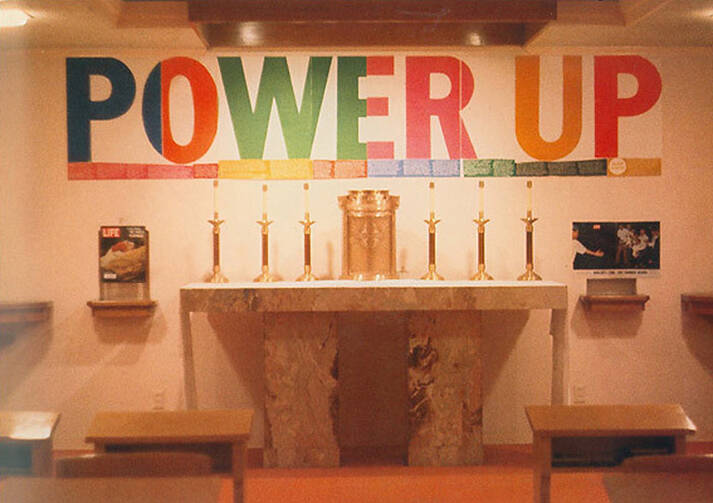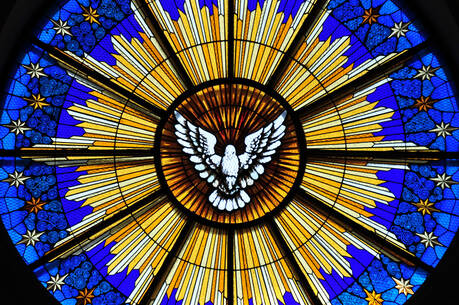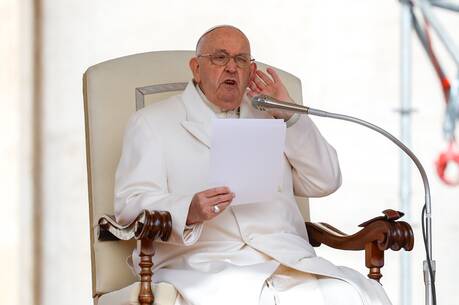Cambridge, MA. The semester is passing speedily, and we are past the half-way point. I realize then that I still have not called your attention to the wonderful exhibit currently at the Fogg, Harvard’s gloriously refurbished art museum, "Corita Kent and the Language of Pop." Sister Corita Kent (born Frances Elizabeth Kent; 1918-1986) was for three decades a member of the Congregation of the Immaculate Heart of Mary. During those years, and for the last 18 years of her life as an independent artist, Corita worked with silkscreen, and produced wonderfully bright and vivid images. I could add to this column only one such image, but you can find many more online, e.g. at Google Image—or in the very informative and learned catalogue for the exhibit, Corita Kent and the Language of Pop, edited by Susan Dackerman and containing many of Corita’s images, plus those of a wide range of other artists including Robert Indiana, Jasper Johns, Roy Lichtenstein, Faith Ringgold, May Stevens, and Andy Warhol. The volume is learned, and includes too analytic articles by a range of most perceptive scholars. Best of course is to come to the exhibit if you can (at the Fogg until Jan. 3, 2016, and then at San Diego’s Museum of Art, Feb. 13-May 8, 2016). The still more interested will want to visit the library exhibit at Harvard’s Schlesinger Library, between now and Dec. 4.
I am no artist or art historian, and can offer just a few insights, lest the occasion slip by, and while the Fogg exhibit has two months to go.
Corita richly and vividly draws together word and image, doing with apparent ease what many of us professors talk about but never quite do: bring into organic harmony what we see and what we say. In her silkscreen paintings, vivid colors and images catch our eye and delight us. Yet too, what we see is turned into a fresh eye on our world, cultural critique, resistance to the Vietnam War, and the disclosure of spiritual insight, color and shape—all become the stuff of spiritual reflection.
Nothing is safe from her sacred magic. The common sign, “Do Not Enter / Wrong Way” segues into Simon and Garfunkel’s “Slow down you move too fast,” written in small print, and then too accompanied by Edward Field’s prose poem, “Tailspin,” which ends, “the trick is, as in everything, to go with the turning willingly rather than fight, give in, go with it, and that way come out of your tailspin whole.” A bread bag’s caution—“Extra Soft”—is headed with words from C.S. Lewis’ Mere Christianity: “You may say ‘I’ve never had the sense of being helped by an invisible Christ, but I often have been helped by other human beings.’ That is rather like the woman in the first war who said that if there were a bread shortage it would not bother her house because they always ate toast. If there is no bread there will be no toast.”
In one notable triptych, a long letter/poem by Daniel Berrigan, S.J., spreads across the bottom of the page dominated on top by Richfield Oil’s “Power Up” slogan. “When I hear bread breaking I see something else; it seems almost as though God never meant us to do anything else. So beautiful a sound, the crust breaks up like manna and falls all over everything, and then we eat; bread gets inside humans.” Another bright image, “Wonder Bread,” is startlingly accompanied by a meditation from Albert Camus’ “Create Dangerously”:
Great ideas, it has been said, come into the world as gently as doves. Perhaps then, if we listen attentively, we shall hear amid the uproar of empires and nations, a faint flutter of wings, a gentle stirring of life and hope. Some will say that this hope lies in a nation; others, in a man. I believe rather that it is awakened, revived, nourished by millions of solitary individuals whose deeds and works every day negate frontiers and the crudest implications of history. As a result, there shines forth fleetingly the ever-threatened truth that each and every man, on the foundation of his own sufferings and joys, builds for all.
And, of course, ee cummings shows up again and again, as in “Someone Up Here Likes You,” a scene crossed by cummings’ immortal words, “Damn everything but the circus”—and, in the tinest letters, his other lovely words: “nor a first rose explodes but shall increase / whole truthful infinite immediate us” and “we are so both and oneful / night cannot be so sky / sky cannot be so sunful / i and through you so i”
But who those who have not time to stop and read the fine print, there is always the Gas Tank on 93 South, outside Boston. (And you can even buy a tiny replica of it in the Fogg Gift Shop.)
And so on! Seeing it all will be much better of course, but I think you get the idea: colors and brush strokes that illumine words, words that explore the depths of elemental colors and shapes.
I close with a different thought: Sister Corita turns out to be providential seer for the church of Vatican II in America. We are nearing the end of the 50th anniversary commemorations of the Council—I will post a reflection on the 50th anniversary of “Nostra Aetate” in a few days—and rightly have marked in every way that grace-filled event and the ups and downs of the decades since. The Council mattered greatly; how it was received, in every corner of the world, matters too, and Corita was one of the great figures welcoming the Council to America. Pope Francis was right to mention Abraham Lincoln, Martin Luther King, Dorothy Day, and (during his birth centenary) Thomas Merton, in his speech before Congress; had he another moment, though, he could have added Corita Kent, who helped a generation and more to see the world afresh, and hear and read it with newly opened ears, all by her silkscreens, so simple, bright and colorful and much more too, at home in pop culture, bountiful in some of our best words and tired mundane words made better—finding at every turn some small glimpse of God near our every sense. An artist and visionary—a doctor of our church as it sees and imagines—Corita showed us how to give flesh and blood to the Council with an abundance of life. (I can't help but add: Harvard Divinity's annual Dudleian lecture this year addresses the question of the reception of Vatican II in the American religious landscape; if you are nearby to Boston/Cambridge, come on Wednesday, October 28, at 5:15pm, to hear Professor Kathleen Cummings (Notre Dame) speak on “American Afterlives: U.S. Nation-Saints and the Second Vatican Council.”)
But see Corita for yourself. Visit the Fogg if you can, or in the spring see her in San Diego—or on Google Image!







